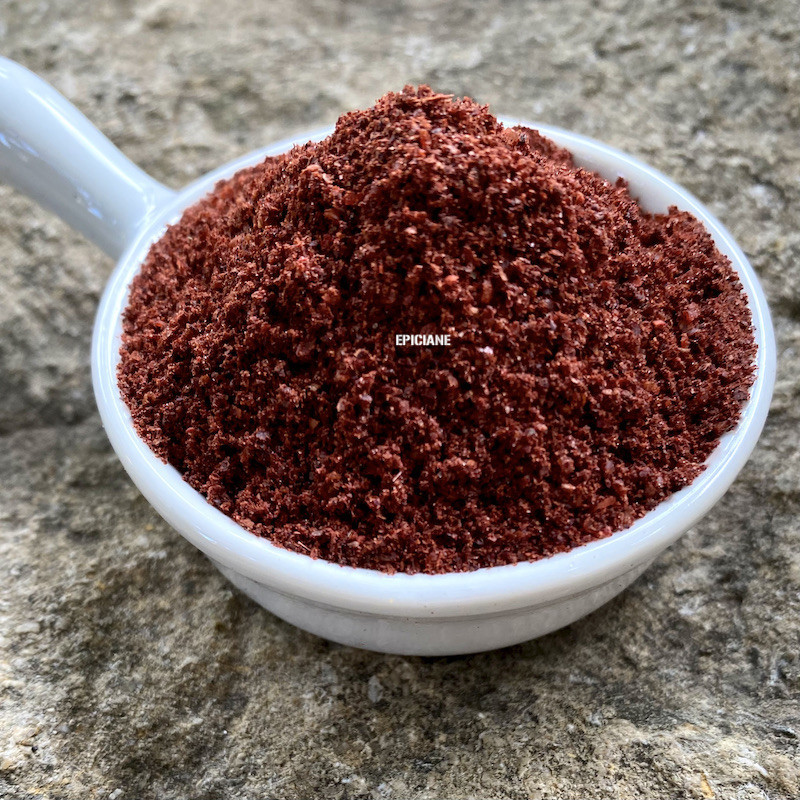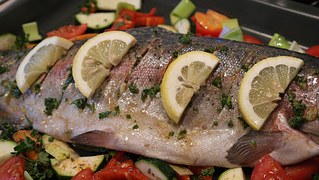
Reference: 20727901


Sa saveur acidulée et salée en même temps est très étonnante!
Il parfume traditionnellement les poissons, les fruits de mer et même certaines viandes dans la cuisine libanaise. Mais surtout, il trompe le palais dans un régime pauvre en sel !
 Delivery
Delivery
Mondial Relay
 Returns
Returns
See conditions
 Payments
Payments
100% secure
Delivered in a resealable pouch
 The taste of sumac is tangy and naturally salty, enhanced by a small amount of salt for preservation. It is very interesting because it allows people on a low-salt diet or those wishing to reduce their salt intake to still make their dishes very flavorful. Indeed, it "tricks" the consumer’s palate by giving the illusion that the dish contains more salt. It can also replace lemon in dishes.
The taste of sumac is tangy and naturally salty, enhanced by a small amount of salt for preservation. It is very interesting because it allows people on a low-salt diet or those wishing to reduce their salt intake to still make their dishes very flavorful. Indeed, it "tricks" the consumer’s palate by giving the illusion that the dish contains more salt. It can also replace lemon in dishes.
This bordeaux-colored powder is widely used in Lebanon, Syria, Iran, and Iraq to season fish and seafood, certain meat dishes (especially lamb), kebabs, minced meat, rice, and even salads. If mixed with yogurt and chives, it makes an excellent dipping sauce. It is also often served separately at the table, so each diner can sprinkle it on their dish to taste.
Finally, sumac is also a component of zaatar, a blend of sumac, thyme, and sesame seeds consumed, especially in Lebanon, on vegetables or simply with bread lightly dipped in olive oil.
Ingredients: Contains 8% salt for preservation

Origin: Turkey
Scientific name: Rhus coriaria
Common name: Sumac of tanners, traveller's sumac, corroyère
This spice is made from the dried berries of the tree, which are ground into a slightly granular bordeaux-colored powder used in Middle Eastern cuisine.
Sumac (or simmeck in Lebanon) belongs to the Anacardiaceae family, which includes mango and pistachio trees. This family of plants consists of around 125 species, most of which are found in warm and temperate regions. Our sumac is a shrub 3 to 4 meters high, native to Southern Europe and the Near East, with fragile and brittle branches containing marrow. The tree's leaves are deciduous, large, velvety on the underside, and composed of lanceolate, serrated leaflets. In the fall, the foliage turns a very aesthetic orange/red. The flowers appear in terminal panicles.
Among the many varieties of this family, several are toxic, including the best-known variety to gardeners, Virginia sumac. This species, native to America, has become an invasive species in Southern France due to its rapid reproduction.
As its other name suggests ("coriaria" comes from "corium," meaning leather), the leaves of this "tanners' sumac" are used in leather tanning due to their high tannin content. They are harvested at the end of summer. This tanning makes the leather supple and light, like morocco leather, which is often tanned with sumac.
°°°
The name "Rhus" was already used by the Greeks and Romans, who consumed sumac like lemon today, before lemon trees had arrived in Europe!
English: Sicilian sumac
***
Data sheet
 DANIELE K.
DANIELE K.
En attente de consommation.

 DANIELE K.
DANIELE K.
En attente de consommation.

Reference: 2N7072401
Reference: 6L5609803
Reference: laurierE
Reference: 6L5609802
Reference: EPI2301003
Reference: souci
Reference: 00036306-0001
Reference: 11N78924G1
Reference: 2071570
Reference: anisvertM
Reference: kenya
Reference: 408190301
Reference: 00723801
Reference: 30811001
Reference: 20715402
Reference: safranpistil
Reference: OF35029
Reference: quatreepices

Sa saveur acidulée et salée en même temps est très étonnante!
Il parfume traditionnellement les poissons, les fruits de mer et même certaines viandes dans la cuisine libanaise. Mais surtout, il trompe le palais dans un régime pauvre en sel !